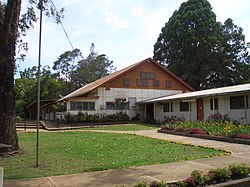Ukarumpa
| Ukarumpa | |
|---|---|

Meeting house
|
|
| Location within Papua New Guinea | |
| Coordinates: 6°20′S 145°54′E / 6.333°S 145.900°E | |
| Country | Papua New Guinea |
| Province | Eastern Highlands |
| District | Kainantu District |
| LLG | Kainantu Rural LLG |
| Established | 1956 |
| Elevation | 1,500 m (4,900 ft) |
| Population | |
| • Total | 600 |
| Languages | |
| • Main languages | English, Tok Pisin, Gadsup, Tairora |
| Time zone | AEST (UTC+10) |
| Location | 11 km (6.8 mi) from Kainantu |
| Climate | Cfb |
Ukarumpa is an international community that is the main center for Summer Institute of Linguistics (SIL), located in the Eastern Highlands Province of Papua New Guinea. It lies approximately 11 kilometres (7 mi) by road from Kainantu in the Aiyura Valley. The population consists of a variety of Christian workers, their families and employees. The base was established in the mid-1950s by Wycliffe Bible Translators. The current population is approximately 600.
The 99-year lease for the 500 acres (2.0 km2) at Ukarumpa was signed by Dick Pittman, accompanied by founding Director, Dr. James C. ("Jim") Dean for the Summer Institute of Linguistics on 4 October 1956. In early 1957, Jim Dean, his wife Gladys and their four children, Sharon, Timothy, Roseann and David, became the first family to take up residence at Ukarumpa. They lived in one of the first native-materials houses built on the property. (Their fifth child, Jonathan, was born in the coastal city of Lae in 1962).
Jim Dean was the founding Director of the Summer Institute of Linguistics in the (then) United Nations mandated Australian Trust Territory of New Guinea, and remained as Director until he was reassigned to establish the S.I.L. operations in India in the mid-1960s.
The 500 acres (2.0 km2) had been the Peacock Plantation, a failed commercial venture. Before that, however, it was a plot of land that was used as the tribal war lands of the nearby tribes (and traditional enemies), the Gadsup and Tairora. Because the land was vacant in the mid-1950s, and only a portion of it, near the Bae'e river, was suitable for gardens, the Australian administrators offered it as one of several potential sites for the SIL base of operations.
Originally the land was open kunai (a type of waist-high grass with sharp-edged leaves) with few trees and no development. The members built homes and planted trees which continue to attract bird life. All of the buildings and roads were built by mission volunteers with financial donations from churches and individuals in their home countries.
...
Wikipedia

